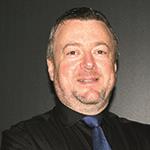I have known Brian Bussey (pictured) for many years. In his capacity as area manager for Haag-Streit UK, he and I have played with many an example of the latest technology as it came to market (remember the Heidelberg Retinal Tomograph anyone?). When recently preparing the paper on selective laser trabeculoplasty or SLT (see Optician 29.03.19), I remembered Brian once telling me that he had undergone the procedure some years back. Who better, I thought, to ask about deciding to have SLT performed and what the results were like?
Q: When did you first have SLT? Was just the one treatment required?
A: In my position (as area manager for Haag-Streit UK), I supplied the very first SLT laser delivery system in the UK (manufactured by Ellex) way back in 2004. I have been involved with SLT over the subsequent years and so my knowledge of SLT is understandably better than many – though obviously not quite as profound as my consultant. I had SLT performed on me in July 2006.
Q: Were you previously on drops, or was SLT the first-line treatment?
 A: SLT was first line treatment for me. I had known about my own risks regarding glaucoma since my days in practice. I previously had worked at Hodd, Barnes & Dickins in London back in the 1990s. It was here that I was first told about my optic discs having deep-cupping, evident during a routine optometric examination (figure 1). Subsequently, while working for Haag-Streit UK and during a trial of the forerunner to our Lenstar Biometer, my corneas were measured at 478 and 480 microns, so significantly thinner than the average. Consequently, I was advised to have an examination by an ophthalmologist and of course, I know several good, glaucoma consultants.
A: SLT was first line treatment for me. I had known about my own risks regarding glaucoma since my days in practice. I previously had worked at Hodd, Barnes & Dickins in London back in the 1990s. It was here that I was first told about my optic discs having deep-cupping, evident during a routine optometric examination (figure 1). Subsequently, while working for Haag-Streit UK and during a trial of the forerunner to our Lenstar Biometer, my corneas were measured at 478 and 480 microns, so significantly thinner than the average. Consequently, I was advised to have an examination by an ophthalmologist and of course, I know several good, glaucoma consultants.
Professor Ejaz Ansari (consultant ophthalmic surgeon at the Eye, Ear and Mouth Unit, Maidstone Hospital, Tunbridge Wells Hospital and Sevenoaks Hospital) measured my intraocular pressures with Goldmann applanation tonometry and found them to be right 17 and left 18mmHg. He carried out a full visual examination and confirmed that I had normal tension glaucoma. Luckily, full threshold fields examination demonstrated nothing untoward. Professor Ansari stated he would like to achieve a reduction in pressures to below 12mmHg.
We then had a discussion to review options as to how best to proceed, and he offered the following options:
1 Do nothing; wait to see what happens. This was unpalatable in my view.
2 Proceed with drops. Again, I thought this also unpalatable. I know and am quite prepared to admit that I am one of the 50% of our population who are non-compliant when it comes to using drops for any length of time.
3 SLT. This seemed to be the perfect solution for me.
Q: Can you briefly take us through the experience from attending the appointment to leaving? What was done and how long did it take?
A: The treatment lasted about 20 minutes. Professor Ansari treated both eyes and applied laser over the full 360 degrees to each trabecular meshwork using a specific SLT contact lens. On a few occasions, I felt a slight, sharp stinging sensation in each eye. This was probably the laser beam striking a nerve, but wasn’t particularly uncomfortable. At the end of the procedure, Prof Ansari prescribed some non-steroidal anti-inflammatory medication for use over the following three days.
Q: Since SLT, how are you monitored? Are you still under the Hospital Eye Service, or monitored in community practice?
A: My pressures had not changed at my three-day or three-month post-treatment follow-up examinations, which Prof Ansari described as quite common and expected. However, at my six-month examination, my IOPs had lowered to right 10 and left 11mmHg. Since then, I have been monitored by routine community optometry examinations (with Niall O’Kane in Kent). Regular Goldmann applanation tonometry has shown that my pressures have remained stable ever since. Importantly, my visual fields (both with Humphrey 24-2 and Octopus 24-2 Dynamic – which I prefer, due to the better test locations and strategy of the Octopus 901 perimeter) have demonstrated no visual field defects.
My decision to opt for SLT has meant that I have maintained stable IOPs for 13 years without drops.
